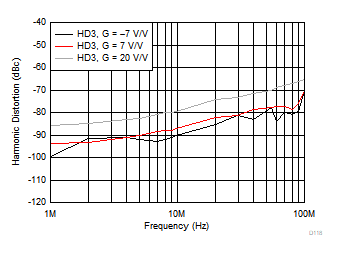SBOS629A April 2018 – July 2018 OPA858
PRODUCTION DATA.
- 1 Features
- 2 Applications
- 3 Description
- 4 Revision History
- 5 Device Comparison Table
- 6 Pin Configuration and Functions
- 7 Specifications
- 8 Parameter Measurement Information
- 9 Detailed Description
- 10Application and Implementation
- 11Power Supply Recommendations
- 12Layout
- 13Device and Documentation Support
- 14Mechanical, Packaging, and Orderable Information
Package Options
Mechanical Data (Package|Pins)
- DSG|8
Thermal pad, mechanical data (Package|Pins)
- DSG|8
Orderable Information
7.6 Typical Characteristics
VS+ = 2.5 V, VS– = –2.5 V, VIN+ = 0 V, RF = 453 Ω, Gain = 7 V/V, RL = 200 Ω, output load referenced to midsupply, and TA = 25°C (unless otherwise noted) Figure 1. Small-Signal Frequency Response vs Gain
Figure 1. Small-Signal Frequency Response vs Gain 
| VOUT = 100 mVPP |

| VOUT = 100 mVPP; see Figure 45 for circuit configuration |

| VOUT = 2 VPP |

| Small-Signal Response |



| VOUT = 2 VPP |

| VOUT = 2 VPP |

| Average Rise and Fall Time (10% - 90%) = 450 ps |


| VS+ = 5 V, VS– = Ground |

| Small-Signal Response |

| 2 Typical Units |

| 30 Units Tested |

| µ = 1 µV/°C | σ = 2.2 µV/°C | 28 Units Tested |

| VS = 5 V | 3 Typical Units |

| VS = 3.3 V | 3 Typical Units |



| µ = –0.28 mV | σ = 0.8 mV | 4555 units tested |

| VOUT = 100 mVPP |

| VOUT = 100 mVPP |

| VOUT = 2 VPP |

| VS = 3.3 V | VOUT = 1 VPP |

| Small-Signal Response |

| Frequency = 10 MHz |


| VOUT = 2 VPP |

| VOUT = 2 VPP |

| Average Rise and Fall Time (10% - 90%) = 750 ps |

| 2x Output Overdrive |

| VS+ = 5 V, VS– = Ground |

| Small-Signal Response |

| 2 Typical Units |

| 3 Typical Units |

| VS = 3.3 V | 3 Typical Units |


| VS = 5 V | 3 Typical Units |

| 3 Typical Units |

| µ = 20.35 mA | σ = 0.2 mA | 4555 units tested |

| µ = –0.1 pA | σ = 0.39 pA | 4555 units tested |